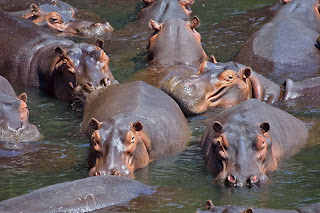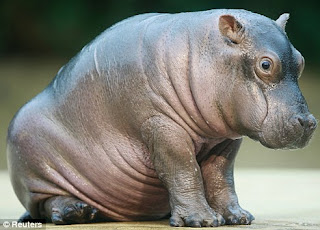Since I'm on a roll with the whole dangerous African animal thing, I think I'll feature the Hippopotamus next. Its name derives from the ancient Greek for "river horse", although it is rather large to be a horse. In fact, is the third largest land mammal, beat only by the elephant and the rhinoceros. Even though it is called a "horse" in ancient Greek and resembles a pig, it is actually most closely related to the order that includes whales and porpoises. The hippo is a semi-aquatic mammal inhabiting the rivers, lakes, and mangrove swamps of Africa. It is one of the most aggressive animals in Africa, and have been known to attack humans even when unprovoked. One look at these porky guys and you'd probably think "Hey, no problem, I can outrun that stubby-legged blob". I know I did. However, it appears that this thought process is faulty; a hippopotamus can easily outrun a human, easily reaching a speed of 19 miles per hour over short distances. So don't let its roly-poly appearance deceive you, because it can SQUASH YOU!
As I mentioned, a hippo can easily squash you once it catches you with its surprising speed. The average weight for adult males ranges from 3,300 - 4,000 pounds, while the average weight for females ranges from 2,900-3,300 pounds. Males hippos seem to continue growing throughout their lives, and some have been recorded to reach weights just shy of 10,000 pounds. Their weight and specific gravity allows them to sink to the bottom of a river, where they can run or walk along the bottom. Despite being semi-aquatic and having webbed feet, an adult hippo is not a very good swimmer and (big surprise) it cannot float. They measure 11-17 feet in length and are about 5 feet tall at the shoulder. They have relatively small (stubby) legs because the water in which they live reduces their weight burden. Its skeletal structure is graviportal, meaning that it is adapted to carrying enormous weight. They can remain in water with most of their body submerged because their eyes, ears, and nostrils are placed high on the roof of the skull. They are thick-skinned, with skin up to 6 inches thick, which provides it with protection against physical injury. This skin secretes a natural sunscreen that is red-colored and sometimes called "bloodsweat" despite the fact that it is neither blood nor sweat. The hippo has an extremely powerful jaw that can open up to 150 degrees. It has enlarged lower canines and lower incisors that grow continuously and can reach lengths of up to 20 inches. Like the warthog, its teeth sharpen themselves as they grind together, making its mouth a very dangerous place to be.
Hippos spend most of their days wallowing in water or mud with other members of their group. These groups are called pods, herds, dales, or bloats, and consist of around 30 animals. Hippopotamuses (or hippopotami, both are correct) are territorial only in water, where the bull presides over a small chunk of river that contains around 10 females. Bachelors are allowed in a bull's territory, as long as they behave submissively. Within the pods, hippos tend to segregate by gender. Not much is known about hippo communication, although they do appear to communicate verbally through grunts and bellows. They have a unique ability to send a cry through both water and air by holding their head only partially above water as it bellows.
Hippos are one of the few mammals that give birth underwater. Baby hippos are born weighing between 60 and 110 pounds, and they must swim to the surface to take their first breath. The baby hippos often will rest on their mothers backs when it deep water, and they must swim underwater to suckle. Hippos are especially aggressive when calves are present. The unfortunate targets of this aggression include crocodiles, lions, spotted hyenas, and even humans. Oddly enough, hippos rarely kill each other. In combat, a territorial bull and a challenging bachelor will stop fighting when it becomes clear that one hippo is stronger. Not the case when a hippo and human are in combat...the hippo is clearly bigger and stronger and will still proceed to squash the poor human.
CHEETAH TIME!!!
Three cubs were orphaned when their mother was shot by poachers in 2005. These cubs were taken in by the Naankuse Wildlife Sanctuary in Namibia, where they were hand-reared by men from the San tribe. Both the cheetah and the San tribe are endangered, so I think that this is a really cool story.











No comments:
Post a Comment